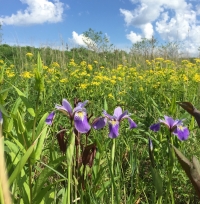I have 5 tricks of the design trade to share that will help you formulate an aesthetically-appealing native plant garden space or tame the wildest of looking yards.
Plant a Mix of Herbaceous & Woody Plants: Incorporating woody and herbaceous plant species will give your plantings year-round interest. Woody shrubs and trees act like the skeleton of any garden space. Their limbs and branches can create accent points, provide shade or privacy as well as visual framework. Herbaceous plants offer continuous color and texture from spring through autumn. Focus on leaf texture as much as flower color to elicit a sense of elegance.
Plant in Drifts & Masses: Planting in drifts creates a sense of rhythm and line. When planting in drifts, the slight gradation changes, be they in color, texture, form or land topography, provide visual stimulation. Anytime plantings are massed into identified groups, a fundamental sense of order is created. Plant different species together in groups of 3+ individual plants. Be sure to repeat these same plant species groupings throughout your garden space or yard.
Space Your Plants Wisely: For restoration projects, the recommended spacing between individual plants is 1-foot-on-center. In a home landscape or house foundation planting, it is important to space plants based on their mature height and spread. Allowing a plant to grow to its full size, naturally promotes fullness, ultimate flower production, and overall heath/vigor.
Keep Your Plants to Scale: The smaller the size of the planting the more specific the placement and understanding of species arrangement is required. Choose plants that do not get taller than the width of your planting beds. For example, if you have a planting bed that is 5-feet wide, the tallest plant should not grow higher than 5-feet.
Mow Your Edges: Defining edges give a naturalized planting a deliberate look and provides evidence of active management. Mowing strips around the perimeter of plantings creates “cues of care” similar to sidewalks or driveways.
This article is written by Michaela Rosenthal: Manager of Land Stewardship





